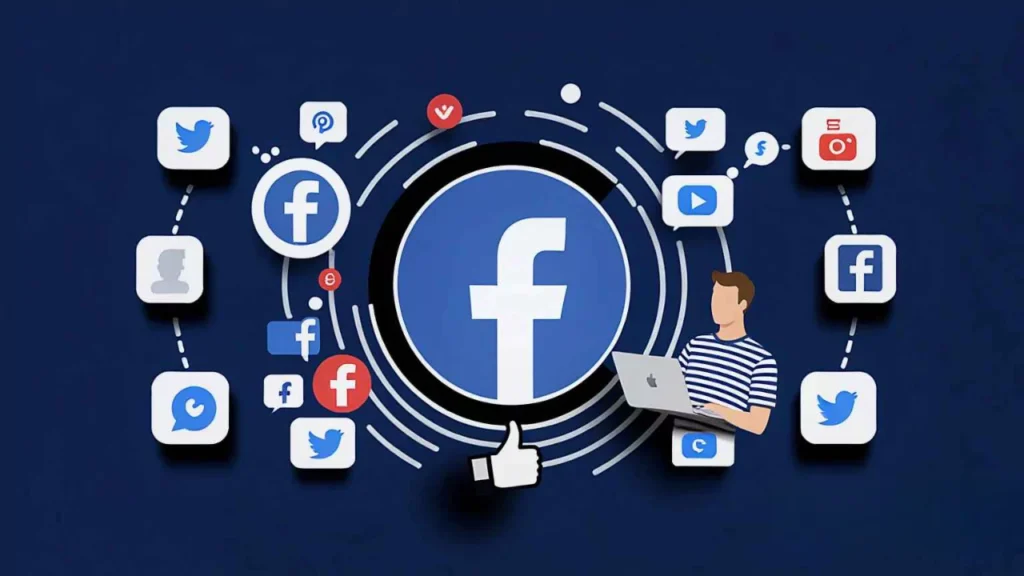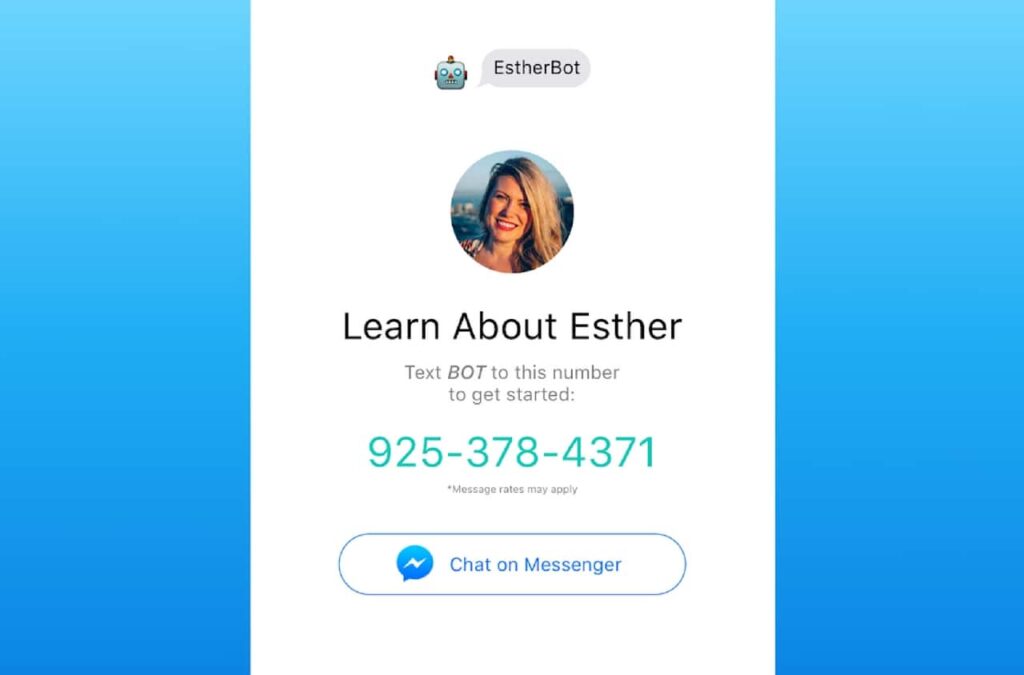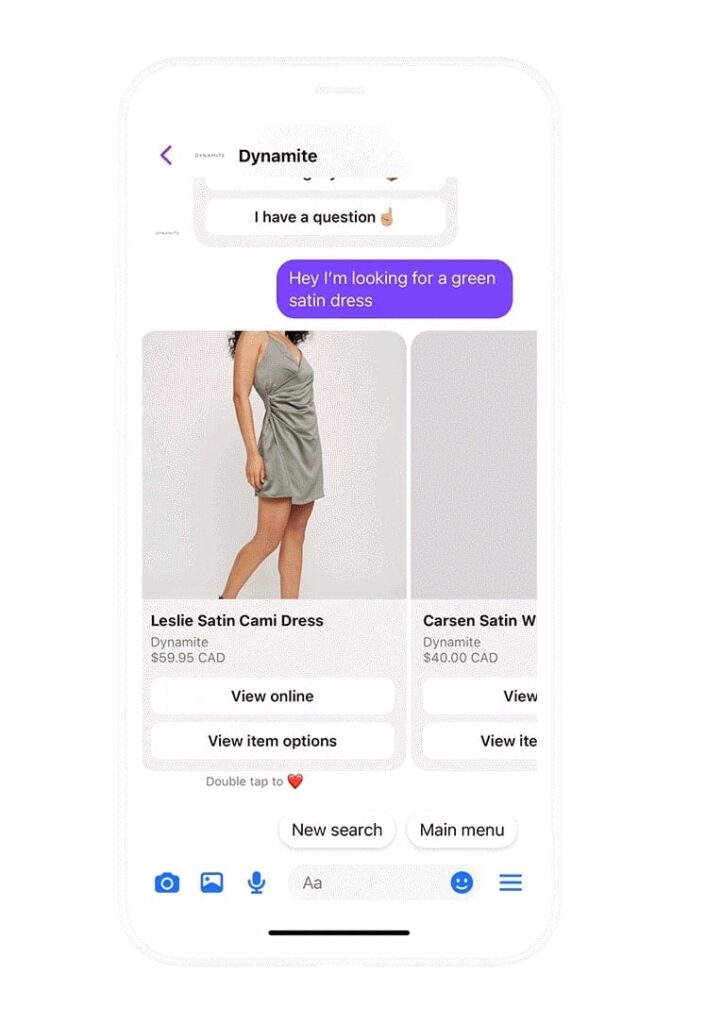Today, chatbots are more than just support tools; in fact, they’re now big players in making your business smoother and more personal. When you design chatbots for specific platforms, they get even better. This is because they use each platform’s special features.
Want to drive sales on Facebook? Boost engagement on Instagram? Or maybe get personal on WhatsApp? In addition, they can even help automate e-commerce support.
These bots can do a lot. With that in mind, let’s look at how they can help your business on different platforms.
Facebook Chatbots: Engaging Customers with AI

What is a Facebook Chatbot?
As of July 2024, Facebook is the most popular social media platform, with nearly 3.1 billion users around the world.
Facebook helps businesses of all sizes connect with their audiences in various ways. One way is through Facebook’s Messenger feature, which lets you respond to your audience’s questions. Normally, a company would have someone specifically assigned to handle and reply to these messages, which can be a lot of work.
That’s where Facebook chatbots come in.
A Facebook chatbot is a chatbot type that interacts with users on Facebook Messenger. It’s designed to automatically respond to messages, answer questions, and engage with users in a conversational way.
How to implement a facebook Chatbot
When setting up a chatbot, you have two main options usually:
- building it yourself.
- hiring a chatbot agency.
Building a chatbot yourself means you take charge of designing, developing, and deploying the bot.
If you choose to build the chatbot yourself, you’ll need to follow several steps. First, you’ll plan the chatbot’s functions and interactions. Next, you’ll use chatbot development tools or platforms to create the bot.
Finally, you can test and launch it on your Facebook page.
On the other hand, hiring a chatbot agency means you let professionals handle it. Agencies have the expertise and experience to design, develop, and set up the chatbot for you.
This option may save you time and guarantees a high-quality outcome.
Best Practices for Designing Facebook Chatbot Conversations
Before selecting a chatbot provider for your Facebook page, remember that your chatbot will do more than just answer questions. (By the end of this article, you’ll see why it’s so much more.)
Think of your chatbot as the voice of your brand on Facebook. You wouldn’t want your representative to be the opposite of who you are, would you?
That’s why, when selecting a chatbot, it is important to choose one with good natural language processing technology.
This way, when you implement your chatbot, it will have the same voice and personality as your company.
Once the voice is finalized, the next step is to make sure your chatbot knows how to talk to your target audience. Every target audience has their own preferences. If you are in the B2B industry, your target customers are often business professionals.
If you are in the B2C industry, you are dealing with regular people. So find a chatbot that will help you communicate with your clients in a way they understand and resonate with.
Also, don’t forget about the length of your chatbot’s replies. Try to use quick replies to keep things flowing. Quick replies guide users smoothly to their next steps saving their time.
Personalization is also important. Address customers by name and refer to past chats. This makes them feel valued and recognized.
Bots are not perfect, and that’s okay. Always include a fallback option for when your bot gets stuck. For example, saying “I’m not sure, but let me find someone who can help” can turn a frustrating moment into a better experience.
Add a bit of humor to your bot. A chatbot with personality can stand out and make users smile.
What Are Facebook Lead Generation Ads?
As we discussed, chatbots have lots of functions. They are typically used for activities such as answering inquiries, providing information, or guiding people.
A lead generation chatbot serves a different purpose. To understand it, let’s first understand what a “lead” is.
A “lead” is a stranger with the potential to become a future customer. These curious strangers ask you relevant questions and show interest in your service or product. But they are not ready to buy into your services yet. They might still be unsure about your product, your brand, or considering other options.
Identifying these leads can be greatly beneficial for businesses.
If you invest your time and effort into nurturing these leads, it’s only a matter of time until they become customers.
These lead generation chatbots are designed specifically to collect contact information. Their main goal is to gather user data like names, emails, and phone numbers through automated conversations.
Why? So they can directly capture and store user data for follow-up. They are optimized for data collection and lead management. Even better, you can integrate this data with Customer Relationship Management (CRM systems) and marketing tools.
Integrating Facebook Chatbots with CRM Systems
CRM systems are software platforms where you can find details about your customers.
These platforms are designed to manage and analyze customer interactions and data throughout the customer lifecycle. If you want to learn which customers are getting closer to purchasing your product and who’s distancing from your brand, CRM has the answer for you.

Now, we talked about lead generation chatbots’ ability to collect user data. While some chatbots store this data in their databases, some chatbots will transfer that data directly into your CRM. That’s half of the story. They can automatically capture and record interactions with users in real-time.
How to Improve and Elevate Lead Generation on Facebook with Chatbots
It’s clear that lead-generation chatbots are immensely helpful for businesses.
Chatbots are great at asking the right questions to identify whether a user is a potential lead or just browsing. They can guide users toward clear actions, like visiting your website, signing up for your newsletter, or checking out products. By collecting key information such as names, emails, and preferences, chatbots make it easier to follow up with leads and turn them into customers.
However, simply implementing a Facebook chatbot won’t deliver the results you’re aiming for overnight.
To get the best results from your lead generation chatbot, follow these steps:
- Set clear goals. Decide exactly what you want your chatbot to do, like collecting contact info, setting up appointments, or finding leads.
- Personalize interactions. Make sure your chatbot matches your brand’s style and connects with users on a personal level. Every message should build a stronger connection.
- Make the conversation flow smooth. Design the chatbot to be easy to use, guiding users through giving their details or answering questions.
- Use triggered messages. Set up messages that pop up based on user actions or times, like offering help if someone is stuck on a page or hasn’t interacted for a while. This keeps chats relevant and timely.
Facebook Messenger Marketing with Chatbots
Chatbots don’t just handle lead generation—they keep going. They work 24/7, capturing leads even when your team is asleep. This means you’re always ready to connect with potential customers.
The best part is that chatbots can handle multiple conversations with multiple customers simultaneously.
Unlike humans, chatbots provide instant responses, reducing wait times and leaving a good impression on your soon-to-be customers.
Here are five examples of businesses effectively using chatbots to enhance their marketing efforts.
With these incredible qualities, chatbots can keep your marketing initiatives up and running.
Using AI to Enhance Chatbot Responses on Facebook
Artifical Intelligence, AI has taken over the world with how it managed to simplify things. From designing to software development, AI has left its mark in almost every industry.
AI also found its way into the Chatbot industry, improving chatbots significantly.
AI helped chatbots to understand and learn from each conversation because of Natural Language Processing (NLP) technology. For instance, let’s say a customer is upset, the AI can adjust the chatbot’s tone or even connect them with a real person who can offer more help because of Sentiment Analysis. Let’s look at real-life examples of how AI can help real-life marketing initiatives. Let’s say a customer mentioned they’re interested in hiking gear during a previous chat. Thanks to machine learning algorithms, the chatbot will remember it. As a result, the chatbot is in a position to suggest new hiking boots or a discount on outdoor equipment in a future conversation.
Analyzing the Performance of Facebook Chatbots
Finally, let’s talk performance. How do you know if your chatbot is doing its job? Track key metrics like engagement rates, conversion rates, and response times.
These data points will show you how well your bot is interacting with users and whether it’s driving the results you want. Conduct A/B testing to optimize different aspects of your chatbot—like tweaking the greeting message or changing up the conversation flow.
Regular performance audits are essential; they help you identify areas for improvement, ensuring your chatbot evolves alongside your business goals.
Instagram Chatbots: Boosting Engagement and Sales

How to Use Instagram Chatbots for Lead Generation
It is difficult to think of a more engaging channel than Instagram. As a social media platform, it has literally been designed to draw attention and encourage participation.
Visually striking images, videos, and stories. Easy options for people to like, repost, explore hashtags, and add their own comments. As true fans of the Gram will know, the best part of a post is often the comments section.
Instagram chatbots are automated tools that can chat with users on your behalf. They respond to messages, answer questions, and keep conversations going without needing you or your team to step in. This means you can engage with potential customers at any time, even when you’re not online.
Instagram chatbots can be used in two ways:
- Public Replies
They reply to comments on your posts that everyone can see. - Private Messages
They respond to direct messages sent to your account.
Compliance with Instagram’s Policies
Using Instagram chatbots means you need to follow Instagram’s rules closely. Stick to their guidelines to keep your account safe from penalties.
It’s essential to use your chatbot responsibly—avoid spammy practices that could turn users off.
Be upfront about how you collect and use data, and give users control over their personal information. This way, you not only comply with regulations but also build trust and keep your audience engaged.
Instagram chatbot types
Ad-to-Message Chatbot
This chatbot turns your Instagram ads into interactive experiences. It takes users from the ad straight into a direct message (DM) where you can offer special deals, answer questions, or collect leads.
Customer Service Chatbot
This bot helps with customer service 24/7. It answers common questions, fixes basic problems, and points users to helpful resources like articles or tutorials.
Feedback-Gathering Chatbot
Want to know what your audience thinks? This bot starts conversations to get feedback on your products, services, or brand. It helps you understand customer opinions better.
Ordering, Booking, and Tracking Chatbot
This chatbot makes buying easier. It lets users place orders, book appointments, and track deliveries right in Instagram DMs, making the whole process smoother.
Story Highlights and Bio Integration
To make your chatbot easy for people to find, spotlight it in your Instagram Story Highlights and bio. Use Highlights to offer a quick guide for things like customer support, FAQs, or exclusive offers. It’s like having a handy manual right there in your feed.
Put a direct link to your chatbot in your bio so people can start a chat with just one click. This way, anyone interested in reaching out to your brand can do so effortlessly. By keeping your chatbot visible and accessible, you make sure it’s always ready to engage with your audience.
WhatsApp Chatbots: Building Stronger Customer Connections
What Is a WhatsApp Chatbot?
WhatsApp is a messaging app used by over 2 billion people around the world to send texts, photos, and videos. Businesses can use WhatsApp to easily connect with customers, making it great for quick responses, customer service, and building relationships.A WhatsApp chatbot is an automated program that replies to messages, helping businesses answer questions and handle requests automatically.
Setting Up Your WhatsApp Chatbot
WhatsApp Business API was launched in 2018, and since then, Meta has been working to turn it into a powerful business tool like WeChat in China. As the platform evolves, it’s becoming a key player in global communication strategies. With over 2 billion active users, more businesses are starting to use WhatsApp’s features to reach their customers.
Not everyone can get the WhatsApp Business API easily. To use it, businesses need a special business profile and have to apply. This process is mostly for medium to big companies in certain industries. If you’re a smaller business, you might find it a bit harder to get in, but it’s still possible.
To get started with a WhatsApp chatbot, businesses need to:
- Check WhatsApp’s Commerce Policy to ensure they follow the rules.
- Apply for the WhatsApp Business API and set up a WhatsApp phone number.
Integration with Other Systems
To get the best out of WhatsApp chatbots, it’s a good idea to connect them with other business tools like CRM, ERP, or marketing automation systems. This keeps everything in sync and enhances customer interactions. For instance, if your chatbot is connected to your CRM, it can access customer details and offer more personalized responses.
Similarly, linking your chatbot with marketing tools allows it to send customized offers based on user activity. This integration helps your business run more smoothly and gives your customers a more tailored experience.
User Experience and Engagement Strategies
To keep your WhatsApp chatbot running smoothly, make sure it’s fun and personal. Mix in images, videos, or even voice messages to keep chats exciting.
Make your replies sound real and friendly, not too robotic. Use quick replies and interactive buttons so people stay interested and actually enjoy the experience. Keep it smooth and simple.
E-commerce Chatbots: Automating Customer Support
How AI Chatbots Are Revolutionizing E-commerce
Electronic commerce platforms, or E-commerce platforms, are digital marketplaces where businesses sell their services to their customers. These platforms includes everything from online retail stores to digital services like subscriptions and streaming.
It is worth noting that E-commerce websites operate completely in a virtual space. It means a physical store isn’t available for most of these e-commerce websites. As a result of lack of brick-and-motar shop, the customers interact with these e-commerce businesses entirely through digital means.
Since these stores are all online, there is no store people can walk into.
Buyers deal with sellers through screens, which has good sides and bad sides. Some key issues for E-commerce are giving help all day and night, handling many orders, and making sure buyers have a smooth time without meeting face-to-face.
Customer Journey Enhancement
E-commerce chatbots are super helpful because they work easily with platforms like Shopify, WooCommerce, and Magento. This lets them pull up product info, order details, and customer data right away.
For businesses, this means the chatbot gives fast, accurate info, making everything run smoother. It keeps things in sync so chats are always on point and up-to-date.
Integration with E-commerce Platforms
E-commerce chatbots bring a major advantage by integrating smoothly with popular platforms like Shopify, WooCommerce, and Magento.
This integration allows chatbots to access and update product details, order statuses, and customer information in real time. For businesses, this means the chatbot can deliver accurate and current information, improving efficiency and ensuring a better overall experience for customers. It helps in keeping everything synchronized, so interactions are timely and relevant.
Analytics and Performance Tracking
To get the best out of your e-commerce chatbots, you need to track how they’re doing. Keep an eye on things like customer satisfaction, how fast problems get solved, and how many chats turn into sales.
Checking these regularly shows how well your chatbot is performing and where it needs some fixes. It’s not just about seeing if it works but also making sure it keeps improving and meeting your customers’ needs.
Multilingual Support
As e-commerce businesses grow worldwide, having chatbots that speak multiple languages is super important. These chatbots can talk to customers in their own language, making things easier and better for them.
To do this, you need to teach the chatbot different languages and make sure it understands various language quirks. This way, it can handle any language smoothly and help customers from all over.
Security and Privacy Considerations
When dealing with sensitive customer data, security is crucial. E-commerce chatbots need to follow privacy rules like GDPR to keep user info safe.
This means using secure data storage, encryption, and doing regular checks to make sure everything is protected from breaches. Keeping high security standards helps build trust and shows customers their data is secure.
Future Trends and Innovations
The future of e-commerce chatbots is looking exciting. New tech like advanced AI and machine learning is coming in, making chatbots even smarter.
These upgrades will help chatbots understand and handle complex questions better, so they’re more useful and intuitive. Keeping up with these trends means businesses can use chatbots to their full potential and stay ahead in the e-commerce game.
Conclusion
Think of platform-specific chatbots as your business’s personal helper. They work on Facebook, Instagram, WhatsApp, and more. These bots help with things like shopping or setting up appointments.
They use AI to handle tasks and automate stuff. This means chatbots make chatting with customers smoother and get leads. They also help with support and keep things running better.
With the right bot and plan, the sky’s the limit. There’s so much these clever tools can do.
See how our chatbots can boost your business. Learn about their features to improve customer engagement, streamline operations, and increase efficiency.





